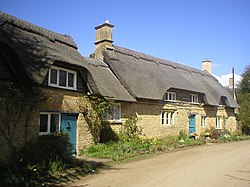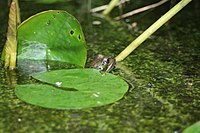Hidcote Bartrim: Difference between revisions
Created page with "{{Infobox town |name=Hidcote Bartrim |county=Gloucestershire |picture=Thatched_cottages,_Hidcote_Bartrim_-_geograph.org.uk_-_138687.jpg |picture caption=Thatched cottages in H..." |
No edit summary |
||
| Line 16: | Line 16: | ||
'''Hidcote Bartrim''' is a tiny village in the [[Cotswolds]] of [[Gloucestershire]], privately owned by the [[National Trust for Places of Historic Interest or Natural Beauty|National Trust]]. The Trust owns all property in the village and act as landlord to each of the ten domestic dwellings. There are ten dwellings, including two substantial farmhouses. Most of the smaller cottages have thatched roofs. | '''Hidcote Bartrim''' is a tiny village in the [[Cotswolds]] of [[Gloucestershire]], privately owned by the [[National Trust for Places of Historic Interest or Natural Beauty|National Trust]]. The Trust owns all property in the village and act as landlord to each of the ten domestic dwellings. There are ten dwellings, including two substantial farmhouses. Most of the smaller cottages have thatched roofs. | ||
The village is half a mile from the border of [[Warwickshire]], to the north and to the east: at the county border to the east if Warwickshire's [[county top]] on [[Ebrington Hill]]. [[ | The village is half a mile from the border of [[Warwickshire]], to the north and to the east: at the county border to the east if Warwickshire's [[county top]] on [[Ebrington Hill]]. [[Ebrington]] itself is further south. The nearest town is [[Chipping Campden]], which is approximately three miles to the south-west. | ||
Half a mile to the south is a sister village, [[Hidcote Boyce]]. | Half a mile to the south is a sister village, [[Hidcote Boyce]]. | ||
Latest revision as of 18:32, 10 February 2020
| Hidcote Bartrim | |
| Gloucestershire | |
|---|---|
 Thatched cottages in Hidcote Bartrim | |
| Location | |
| Grid reference: | SP176430 |
| Location: | 52°5’6"N, 1°44’35"W |
| Data | |
| Population: | 20 |
| Post town: | Chipping Campden |
| Postcode: | GL55 |
| Local Government | |
| Council: | Cotswold |
| Parliamentary constituency: |
The Cotswolds |
Hidcote Bartrim is a tiny village in the Cotswolds of Gloucestershire, privately owned by the National Trust. The Trust owns all property in the village and act as landlord to each of the ten domestic dwellings. There are ten dwellings, including two substantial farmhouses. Most of the smaller cottages have thatched roofs.
The village is half a mile from the border of Warwickshire, to the north and to the east: at the county border to the east if Warwickshire's county top on Ebrington Hill. Ebrington itself is further south. The nearest town is Chipping Campden, which is approximately three miles to the south-west.
Half a mile to the south is a sister village, Hidcote Boyce.
The Monarch's Way long-distance walking route runs through the village, which can bring visitors to the village either from the north by way of Admington or from the south from Chipping Campden. A bridleway runs in from Ilmington.
About the village
Hidcote Manor Garden is one of the best-known and most influential Arts and Crafts gardens in Britain, with its linked "rooms" of hedges, rare trees, shrubs and herbaceous borders. It was created by Lawrence Johnston and today is owned by the National Trust and is opened to the public.[1]
Also adjacent to the village are the Kiftsgate Court Gardens, created by Heather Muir in the 1920s,[2]
Other major attractions include the duck pond, the field with a tree in the middle and the village's ‘avenue of trees’. The latter affords visitors beautiful views of the Warwickshire countryside from a raised vantage point, over 600 feet above sea level.
History
Hidcote Bartrim is named in the Domesday Book of 1086, where it is recorded that the manor was held by the church of St Mary of Evesham.[3] There was one plough and two slaves in lordship and 3 hides (around 400 acres) returning 20 shillings taxable value, not a great deal. Population statistics for 1086 are lacking, although the wives of 4 villagers "who have recently died" have one plough, suggesting some sort of catastrophe in the village (which could of course have been the wars of the Conquest 1066-1075). The Abbot of St Mary gave the village to one of his knights as part of William I's military service.
Hidcote Bartrim was a township of Admington Manor under the overlordship of Winchcombe Abbey. On its south eastern edge are Mediæval earthwork settlement remains which are visible on aerial photographs. These remains are centred on SP 1772 4227 and consist of hollow ways, some flanked on one side by low banks. Earthwork banks also outline possible buildings. Much of Hidcote Bartrim's lands were on the escarpment and to the south east of this settlement is a hollow way that heads eastwards up onto Ebrington Hill. Some adjacent ridge and furrow would have belonged to Hidcote Bartrim. Anglo Saxon javelin head, and a bronze needle was found at Hidcote Bartrim before 1958. Eight of the ten houses existing today date from the late 17th/early 18th centuries, their exteriors largely unaltered although many of the interiors were extensively adapted in the 20th century.[4]
Hidcote Manor was owned by Bradenstoke Priory in Wiltshire until the Priory was disbanded by Henry VIII in around 1539.[5]
The manor house (not to be confused with Hidcote House) was built in the 17th Century as a farmhouse. It passed through several hands before being inherited in early 1907 from the Freeman family by John Tucker, who had farmed there since 1873.
Within a couple of months of probate being granted the estate was put up for auction. It was advertised in The Times on 22 June 1907 as a ‘valuable freehold farm comprising 287 acres’. The land would be sold with a ‘very substantial and picturesque farm house...... with lawns and large kitchen garden’.
At the auction in July 1907, the bidding had reached £6,500, at which point it was withdrawn from sale. Three weeks later Lawrence Johnston, acting on behalf of his mother, agreed to purchase the estate from John Tucker for £7,200.
Wildlife
Deer, foxes, badgers, squirrels, rabbits and other small mammals are common sights in Hidcote Bartrim, as well as frogs and a large variety of birds. Great crested newts and smooth newts are also common. An invasive species of ant, Lasius neglectus, is also present, which is frequently described as a pest by residents.[6]

Hidcote lavender, another name for Lavandula angustifolia, also takes its name from the village.[7]
Outside links
References
- ↑ Hidcote: National Trust
- ↑ Kiftsgate Court Gardens
- ↑ [https://opendomesday.org/place/SP1742/hidcote-bartrim/ Hidcote [Bartrim: Open Domesday
- ↑ Archaeology Data Service
- ↑ History Of Hidcote: National Trust
- ↑ 'Trust property test site for super ant pest control' Louise Gray in The Telegraph 19 October 2009
- ↑ Lavandula angustifolia 'Hidcote': RHS Gardening